
Doc's Daily Commentary

Mind Of Mav
How Ethereum Is About To Change Its Supply & Demand
Bummed about the recent crypto downturn? Don’t be. Crypto is still in this fight, and one of the biggest proponents of crypto’s comeback is Ethereum.
Huge changes for Ethereum are on the horizon, larger than most of the upgrades we have seen since the network’s launch in July 2015. We have Eth2, EIP 1559, and increasing adoption of Layer 2 scaling solutions in prominent Ethereum protocols.
1. Consolidate information and map all the changes together. Most articles cover just one change and some don’t cover tokenomics implications or discuss tokenomics assuming knowledge of the change
2. Explore L2 efforts’ effects on price, which is usually not considered
3. Explore possible demand side changes besides the commonly discussed supply side
Given the article’s length, feel free to skip parts you’re familiar with.
Eth2
What: Eth2 can be broken down into 2 main upgrades: Proof-of-Stake and sharding
Under PoW, blockchain transactions are verified by miners who solve cryptographic problems that require high computational power and energy. The first miner to solve the problem creates a block and is rewarded freshly minted ETH. Meanwhile, in PoS, users stake and lock in 32 ETH to become a validator, which creates and validates blocks like miners under PoW. However, they do not compete to solve a problem, but are rather chosen at random to create blocks and receive rewards. Rewards are thus received in proportion to the amount of ETH staked.
This reduces energy consumption of the network, supports decentralization by reducing expensive hardware requirements and encouraging the creation of more nodes, and makes the network more secure as significant amounts of ETH are needed to launch an attack. This tackles the security and decentralisation aspects of the blockchain trilemma. The scalability aspect, meanwhile, is addressed by Eth2’s sharding.
2. Sharding
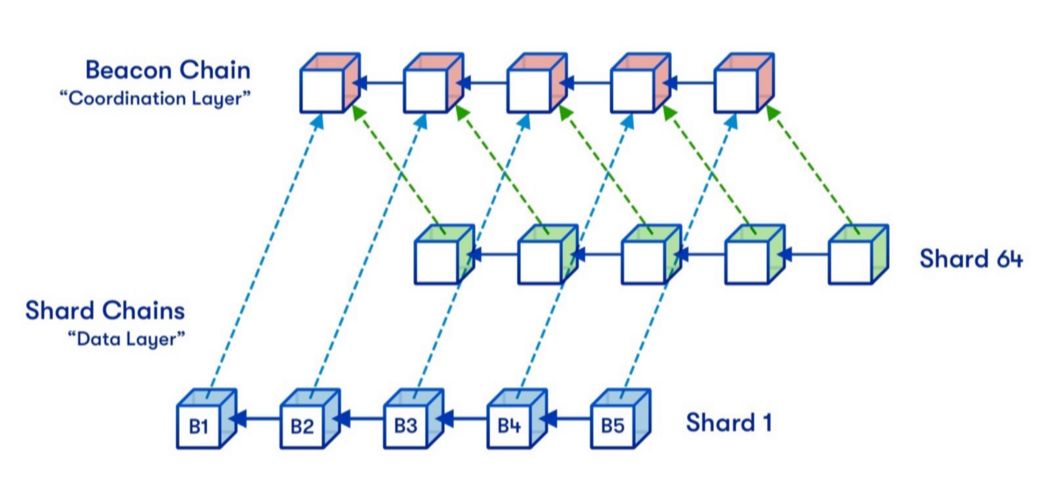
Graphic visualisation of sharding, from Quantstamp
Under the current PoW system, rewards stand at 2 ETH per block and 1.75 ETH per uncle block (created when more than one block is mined at roughly the same time, as only one block can be validated and added to the ledger). Note that rewards were previously higher before February 2019. With an average block time of ~13.15s at the current mining difficulty level, the annual issuance rate stands at ~4.5%.
Under Eth2’s PoS, the issuance rate is dramatically lower and is expected to range from 0.5% to 1+% based on some reasonable assumptions. It is hard to give a precise rate since issuance is dependent on a number of factors:
1. Amount of ETH staked/ No. of validators: more validators generally leads to more ETH issued. However, as validators’ percentage return from staking and thus their willingness to stake decreases when there are more validators, there is a limit to the amount of ETH that would end up being staked.
2. Extent of bad behavior by validators: if validators go offline or behave maliciously by validating wrong transactions, they are penalised through a loss of ETH that gets burned and decreases supply.
Nevertheless, issuance rate is expected to decrease dramatically.
Ethereum Improvement Proposal (EIP) 1559
What: EIP 1559 changes Ethereum’s fee structure and introduces fee burning
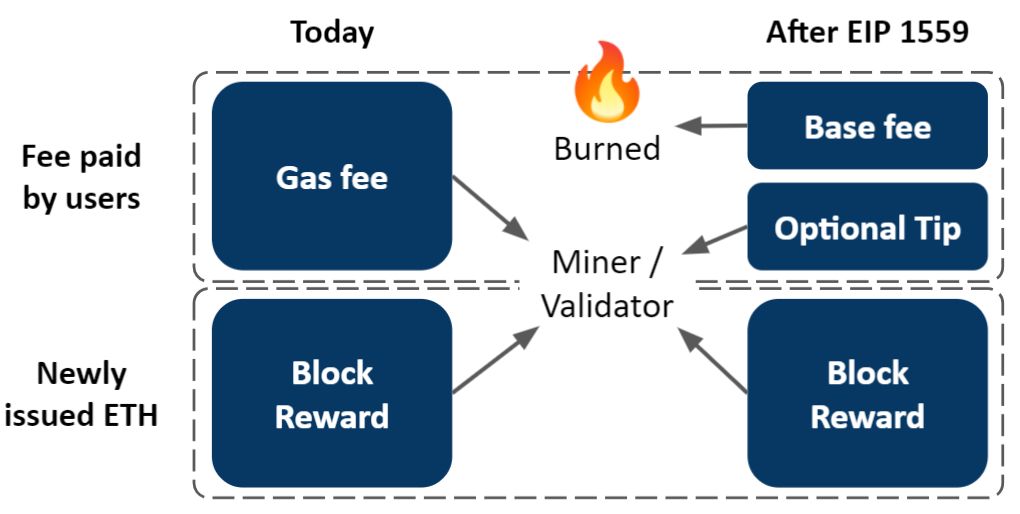
1. Under EIP 1559, transaction fees now consist of two parts: base fees (which are burnt) and an optional tip for miners. Tipping incentivizes miners to prioritize transactions when transaction volume is high.
2. Each block’s gas limit is doubled from 12.5M to 25M, but the target average block size over time is 50% or 12.5M. The target is achieved by increasing the base fee when blocks are more than 50% full (during network congestion) and decreasing it when blocks are less than 50% full.
These changes reduce the need for users to guess the gas price needed for their transaction to be included, leading to a more efficient fee system and less fee overpaying compared to the first price auction model.
Burning of base fees decreases ETH’s supply in proportion to the amount of activity on the Ethereum network as base fees increase to meet the 50% block size target when the network is congested. Estimating the magnitude of the effect is difficult since it’s heavily dependent on network activity. Taking current transaction fees as a proxy is also not fully accurate as we are unsure of the base fee-tip split. Some estimate that EIP 1559 will heavily reduce net issuance to the point where ETH becomes deflationary.
What: These solutions do not change the underlying Ethereum infrastructure (Layer 1). Rather, they reduce network congestion by handling some transactions off-chain. Besides helping with scaling, some solutions provide privacy in an otherwise open blockchain world where all transactions are public.
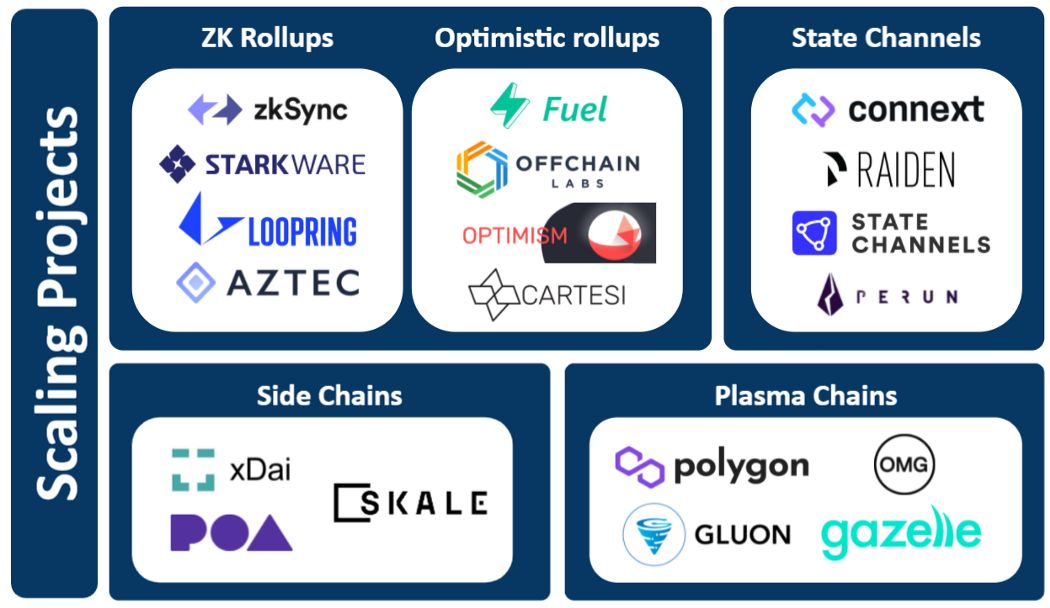
We refer to them as non-L1 scaling solutions as some of the solutions (eg. side chains) are technically not Layer 2, as they are not directly secured by Layer 1. Here is a brief overview of some scaling solutions:
1. ZK Rollups: data on the before and after states (eg. about account balances) are kept on Layer 1. A smart contract conducts transactions on Layer 2 in batches and updates the final state on Layer 1, using a cryptographic proof called SNARK to prove that the final state is accurate.
2. Optimistic Rollups: same as ZK rollups, but instead of proving the accuracy of each state update, updates are assumed to be accurate. Accuracy is only computationally verified if someone challenges a state update, with fraudsters penalized and challengers reimbursed for challenging fees.
3. State channel: setting up channels between parties to form an off-chain network within which many transactions take place. The final state is updated on Ethereum.
4. Side chain: conduct transactions in a separate blockchain with its own consensus mechanism. Assets and data are transferred with Ethereum through a smart contract that locks assets and recreates representative ones in the side chain.
5. Plasma chain: similar to side chains in that it functions as separate chains with their own consensus mechanisms. However, ‘roots’ of each block are published to Ethereum, which makes the system more secure but limits its ability to conduct complex operations.
Timeline: prominent dApps have adopted scaling solutions. Some examples:
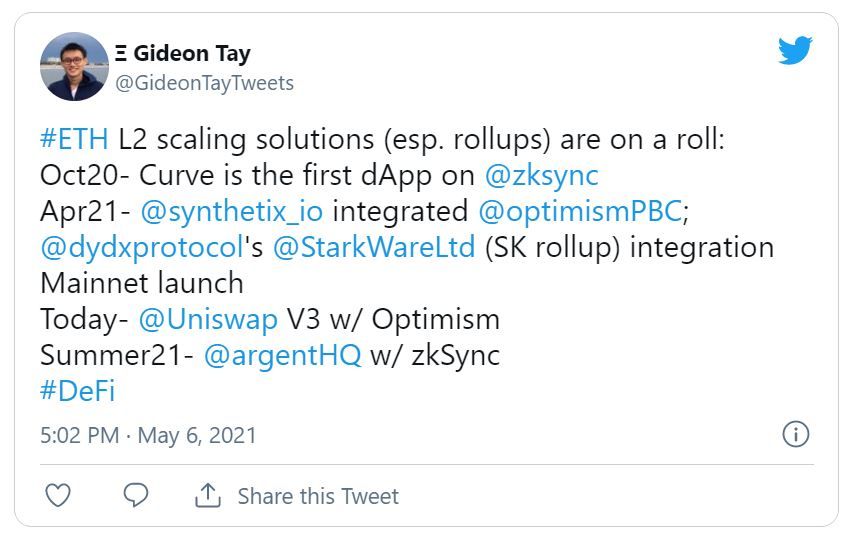
Changes to tokenomics (supply-side)
Before EIP 1559’s implementation in July 2021, scaling solutions would not really affect ETH supply. However, as these solutions are linked with network activity and transaction fees, interesting dynamics emerge when EIP 1559 bridges the gap between fees and ETH supply. Here are some possible effects:
1. Dampening effect: less on-chain activity and transactions per ‘unit’ of dApp activity leads to less base fee burnt under EIP 1559, dampening EIP 1559’s deflationary effects.
2. Counterbalance effect: lower fees provided by scaling solutions attracts new price-sensitive users, increasing dApp participation. This increase arguably counter-balances the effect of less base fee burnt per ‘unit’ of dApp activity. Overall, the ‘true demand’ on the Ethereum network may remain roughly the same.
3. New activity effect: it can be argued that the nature of some scaling solutions would make the movement of new types of economic activity on Ethereum feasible. For example, state channels could be used for micro-recurring payments which is otherwise illogical with high Layer 1 fees. In bringing new types of activity onto Ethereum that still eventually pays some fees that gets burnt, supply could further reduce.
It is hard to ascertain the net effects which could also change over time. Net effects depend on:
1. The extent of scaling solutions’ adoption
2. The amount of new economic activity they facilitate to enter the Ethereum ecosystem
3. Their net effect on the ‘true demand’ on the Ethereum network for on-chain transactions
Demand Side Changes
These changes are likely to lead to an increase in ETH demand and fiat inflows into ETH as they attract investors by:
1. Improving ETH’s attractiveness as an asset: Eth2 converts ETH into a productive asset, capable of generating cash flows through staking. Looking at media reports and ETH’s price run-up prior to the July EIP 1559 implementation, it looks like news of EIP 1559’s deflationary effects on ETH supply has also attracted many investors.
2. Increasing awareness through usage: Eth2’s sharding and L2 scaling solutions improves Ethereum’s scalability and reduces transaction fees for each ‘unit’ of network demand. This makes Ethereum more accessible to retail users with smaller transaction sizes, supporting further adoption and awareness of the ecosystem’s dApps and of ETH itself. This increases the pool of investors interested to purchase and hold ETH.
Bringing it all together
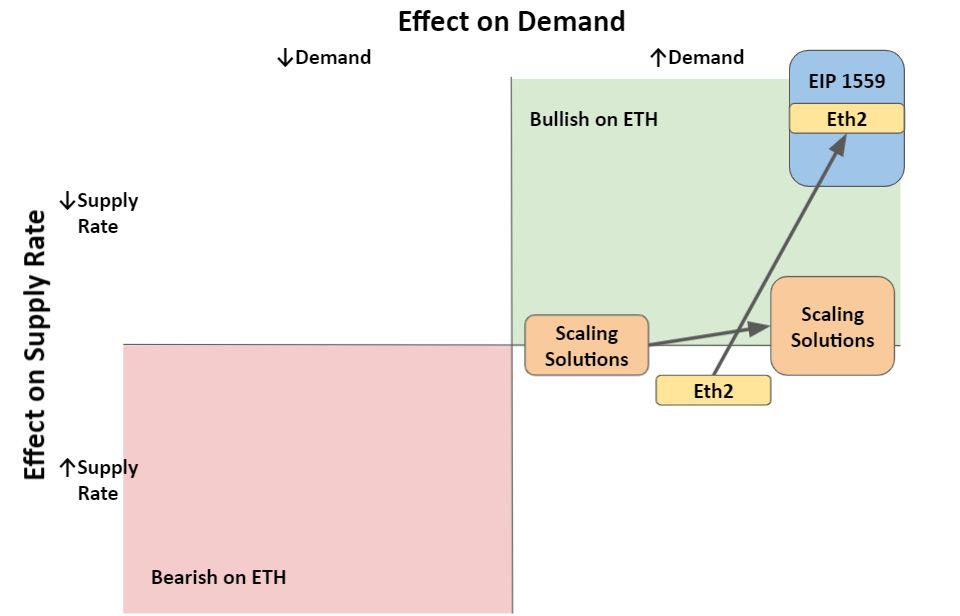
Diagram on the effect of Ethereum infrastructure changes on ETH supply and demand. Arrows indicate expected change over time and box size indicates uncertainty
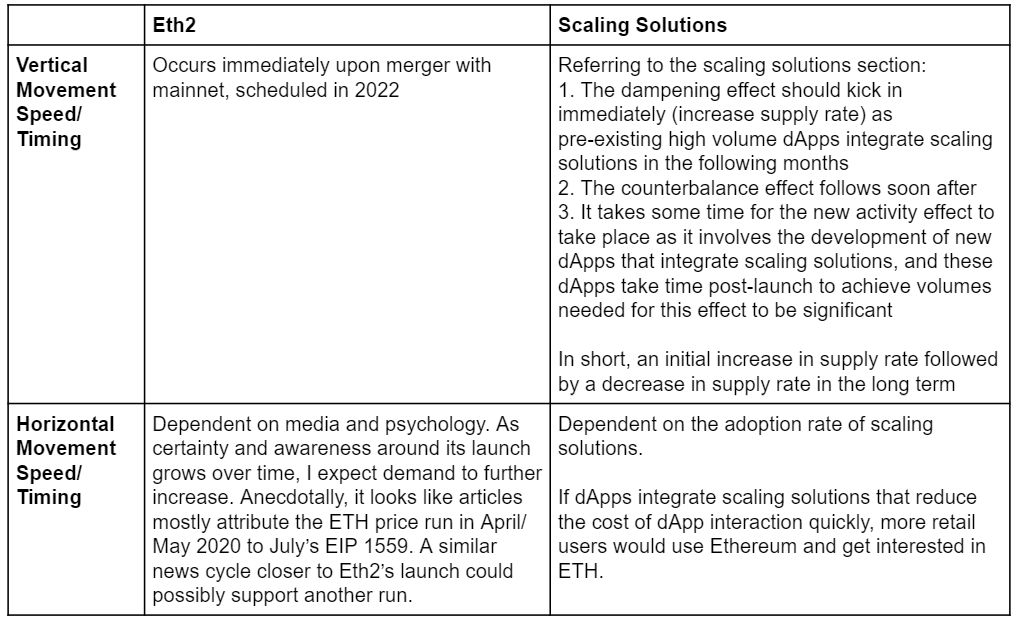
Explanation of the expected timing and speed of vertical/ horizontal movement of ‘Eth2’ and ‘Scaling Solutions’ on the previous chart
Short term: Eth2’s trial increases ETH issuance rate. It also generates increase in demand as investors purchase ETH on the basis that it can be staked for rewards
Long term: Eth2 causes a significant drop in the issuance rate after it is merged with Ethereum mainnet. ETH demand increases leading up to and after the Eth2 launch as awareness increases.
EIP 1559
Once implemented in July 2021, EIP 1559 would cause a significant net ETH issuance rate drop as base fees get burned. On the demand side, it has been a major contributing factor to ETH’s price run up and constant breaking of all-time-highs in April/ May 2021.
While its effect on supply rate is expected to be significant, the box height indicates uncertainty on the precise extent of this effect.
Scaling Solutions
Short term: prior to EIP 1559, it has no effect on supply rate. It has a small positive effect on ETH demand as some scaling solutions are being implemented, attracting smaller users and increasing engagement with Ethereum.
Long term: due to the 3 effects previously discussed, net effect on supply rate is highly uncertain. We hazard a guess that it would be close to zero, with a slight bias toward reducing supply rate in the long term due to the ‘new activity effect’ with more innovative ideas joining Ethereum over time, empowered by scaling solutions. It is expected to have a significant positive effect on ETH demand as it increases Ethereum’s accessibility and thus the number of potential investors interested to purchase ETH.
Closing Thoughts
The chart and our discussion point toward the fact that Ethereum’s infrastructure changes have created strong tailwinds for ETH price by exerting pressure on both the demand and supply side. However, with ETH breaking all time highs constantly, many are left to wonder how high ETH can reach and if these tailwinds have already been priced in.
1. Innovation in the crypto space would disrupt multiple industries, particularly finance, and in doing so create and capture large amounts of value
2. Ethereum has been the market leader in crypto innovation thus far and infrastructure changes are increasing its scalability and hence capacity to dominate the market
3. EIP 1559 links Ethereum’s success to ETH
*This does not constitute investment or financial advice.

The ReadySetCrypto "Three Token Pillars" Community Portfolio (V3)
Add your vote to the V3 Portfolio (Phase 3) by clicking here.
View V3 Portfolio (Phase 2) by clicking here.
View V3 Portfolio (Phase 1) by clicking here.
Read the V3 Portfolio guide by clicking here.
What is the goal of this portfolio?
The “Three Token Pillars” portfolio is democratically proportioned between the Three Pillars of the Token Economy & Interchain:
CryptoCurreny – Security Tokens (STO) – Decentralized Finance (DeFi)
With this portfolio, we will identify and take advantage of the opportunities within the Three
Pillars of ReadySetCrypto. We aim to Capitalise on the collective knowledge and experience of the RSC
community & build model portfolios containing the premier companies and projects
in the industry and manage risk allocation suitable for as many people as
possible.
The Second Phase of the RSC Community Portfolio V3 was to give us a general idea of the weightings people desire in each of the three pillars and also member’s risk tolerance. The Third Phase of the RSC Community Portfolio V3 has us closing in on a finalized portfolio allocation before we consolidated onto the highest quality projects.
Our Current Allocation As Of Phase Three:

Move Your Mouse Over Charts Below For More Information

The ReadySetCrypto "Top Ten Crypto" Community Portfolio (V4)
Add your vote to the V4 Portfolio by clicking here.
Read about building Crypto Portfolio Diversity by clicking here.
What is the goal of this portfolio?
Current Top 10 Rankings:

Move Your Mouse Over Charts Below For More Information

Our Discord
Join Our Crypto Trader & Investor Chatrooms by clicking here!
Please DM us with your email address if you are a full OMNIA member and want to be given full Discord privileges.
